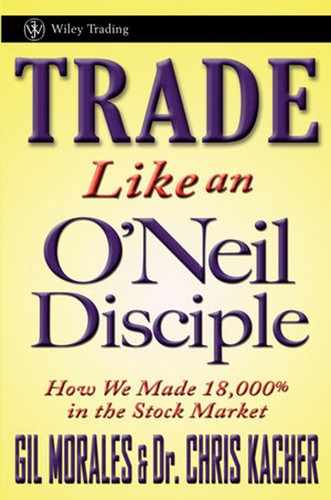3.10. THE THEME OF SUCCESS
In the process of making over 1,000 percent in 1999, some clear themes are evident. The first theme that I believe is most important for investors to understand is the idea that it was not necessarily my thinking that made me so much money. It was, rather frankly, the size of the wave I was riding, and the dot-com bubble bull market of October 1999 to March 2000 was a wave of epic proportion. Just before this massive upside wave appeared, you can see that neither I nor Bill O'Neil, nor perhaps anyone else in the market, had any inkling of what we were about to experience. But when the market turned, despite the fact that we were fairly discouraged and fed up with the market in mid-October 1999, we simply followed our rules and turned with it, buying stocks showing what we believed were driving characteristics that would attract institutional buyers. I didn't make 1,009 percent (that was the exact number) because I was some sort of genius. I simply saw a wave coming and got on with absolutely no idea how long or how big the ride would be. Some simple rules, such as holding a stock for a minimum of eight weeks if it moves up 20 percent within three weeks or less of initially breaking out, provided a simple "collar" that forced me to hold my positions. In a sense, the rule was proven to be quite valid.
Like a surfer who simply jumps on the wave and lets it run its course until it closes out and forces him or her to exit, you simply exercise all your basic rules and techniques to identify, monitor, and then buy a leading stock just as it breaks through the "line of least resistance," where all conditions are lined up like ducks in a neat little row. To a large extent, I think you can chalk up my 1,009 percent performance to being at the right place at the right time: two hot, fast-moving stocks during one of the biggest bubble bull markets in history. Of course, as Bill O'Neil used to tell me, sure there is an element of luck, in that you rely on the magnitude and duration of the bull market to keep your stocks moving higher, but you have to put yourself in those stocks at the right time. In essence, you must work hard to create your own luck!
Making 1,009 percent also did not require that I be diversified in a number of names. I only needed Oracle and Verisign, and in any real bull market this will always be the case. Find one or two big winners, and you will put yourself in the position of making big money in any bull market if you handle them correctly. Oracle and Verisign also did not have picture perfect fundamentals, but understanding their respective roles within the Internet boom was critical in understanding that they would be "big stocks;" in other words, that institutions would have to buy them. This is critical, and it is what Livermore meant when he advised investors to stay in the strongest stocks within the strongest groups.
Another point is that it was necessary to understand that the performance of stocks like Verisign, which was making a mere 2 cents a share in the September quarter of 1999, were being measured and evaluated on the basis of a metric not within the standard "CAN SLIM" fundamental template. In order to capitalize on Verisign, I had to figure out that it wasn't earnings growth that was the driver, but sales growth instead. This was decisive in determining the potential for Verisign. Also, Verisign is a clear example of why P/E ratios are quite simply a "non-determinant" for potential price performance in a stock. P/E ratios don't matter, because the facts prove that they don't.
What I consider to be the most fascinating lesson of my experience as an investor in the dot-com bubble market move that occurred in the last two months of 1999 is that absolutely nobody saw it coming: 1999 proves that a big bull market generally will come when nobody is expecting it, so you must never assume that you can completely ignore the market just because you think it isn't right at any particular point in time. Things can change very quickly in the stock market, and you must absolutely remain attentive and flexible in order to capitalize on what can become opportunities of a lifetime.
The final lesson here is that the basic principles I employed in 1995 and 1999 are easily accessible to any investor who is willing to spend the time and effort to learn them. There is no real magic, since to me successful investing is simply about finding a way to get on board a market-leading "big stock" and then hanging on for as much of the ride as I can. In my view, if I can do it, anyone can. I didn't set out to make 1,009 percent in 1999. I simply put myself in position to capitalize on the biggest bull market of my career at a moment when the ultimate result was unclear and certainly unknowable at the time, but all the conditions were ripe for pushing through the "line of least resistance." It was simply a matter of being there when that line was pierced and then letting the market's trend take care of the rest.
